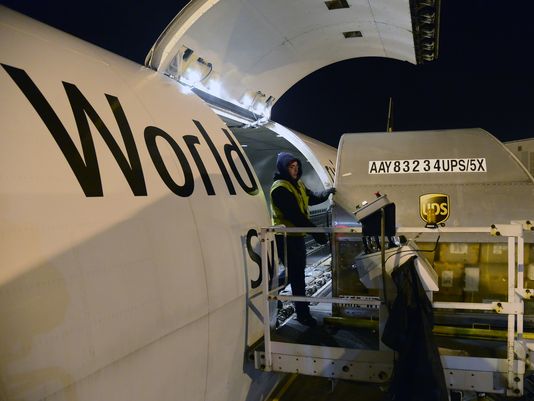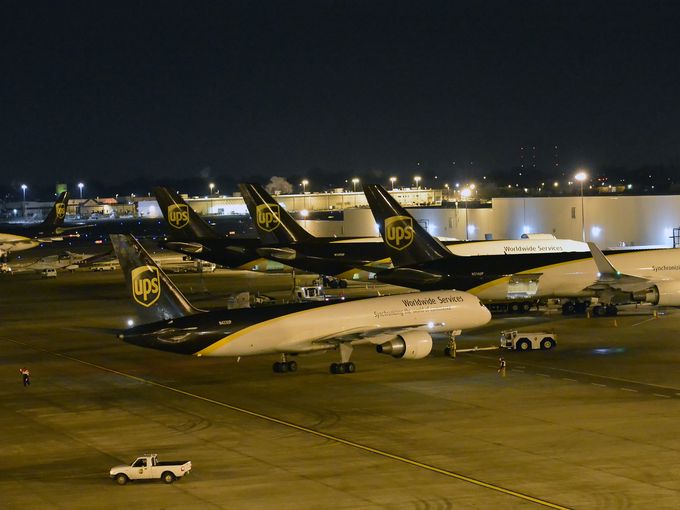UPS is 'organized chaos' on its busiest day
LOUISVILLE, Ky - The small package wrapped in brown paper and decorated with holiday stickers arrived at United Parcel Service's Worldport facility around midnight with an incorrect shipping label.
Within seconds, the package addressed from a child in California to her grandmother in Wisconsin was sent to the "sort exception area" -- more commonly called the "island of misfit toys." It's where all the packages that are mislabeled, unlabeled or damaged go to be fixed in the land of UPS.
"Sometimes you have to provide a little extra care to help get the packages to their right destination," said Jenna Clayton, a package handler and three-year UPS veteran who scanned the box and realized it contained the wrong ZIP code. "You see a lot of things that you know are presents this time of year. It's kind of exciting to be part of that."
Clayton, who printed out a new label and sent the package on its way, is one of nearly 20,000 UPS employees working around the clock to help the world's largest package delivery company embark on a smooth holiday season this year -- one of the shortest seasons on record due to a later than usual Thanksgiving.
Monday marks the highest global pickup day for UPS with some 34 million packages to be picked up across the world -- double the normal volume. Nearly 29 million of those packages will be delivered on Tuesday. Overall, The company expects to deliver more than 129 million packages the week before Christmas, said Dan McMackin, a UPS spokesman. "During this busiest time, we will be delivering about 300 packages per second," he said.
At Worldport, a $2 billion automated processing facility that's roughly the size of 90 football fields (5.2 million square feet), they call these days "the playoffs." They call Dec. 23 -- UPS peak air delivery day -- the Superbowl.
"We prepare for peak season all year long; we have to be ready for anything," "It's organized chaos, but it's fun. This time of year, many of us run on pure adrenaline."said Amy Sitterly, the operations manager of Worldport, which has 70 aircraft docks and 155 miles of conveyor belts capable of sorting 416,000 packages per hour from 220 countries across the globe.
Mike Mangeot, public relations manager for UPS Airlines, said his company expects to handle 7.75 million packages on Dec. 23 with 3.6 million of those packages being sorted and processed at Worldport. "With the rise of e-commerce and online shipping, the peak shipping season has become much shorter," Mangeot said. "Most people click a button on their computers and a box will show up at their door a few days later, but they don't see the 237 jets, 9,000 people and all the meticulous planning and hard work that goes into the magic of Christmas season," says Mangeot.
From the airline mechanics, de-icing operators and a team of meteorologists who monitor the weather 24/7 to pilots, loaders, unloaders and employees like Clayton who help fix problem packages -- UPS has a detailed process designed to keep its system running smoothly and to prevent things from going off the rails, Mangeot said.
In addition to the 237 aircraft that UPS owns and operates, UPS leases an additional 23 jets during the holidays to help with the added volume and the company hires 55,000 season workers nationwide, with over 1,000 assigned to Worldport, to handle packages, Mangeot said.
The work at Worldport is divided into two sorts with roughly 3,000 workers assigned to the day sort, and another 6,000 assigned to the night sort, when . But it's during the nighttime hours that Worldport really comes to life. Everything has to happen between 11 p.m. until about 4 a.m.," McMackin said. "If it doesn't happen by 4 a.m., packages will be delayed," says McMackin.
UPS package handlers greet the pilots as soon as the aircraft land and immediately begin the process of unloading the plane. How many packages are on a plane depends on its size and destination. A 767, for example, can carry up to 24 package containers weighing a maximum of 132,000 pounds.
The average package travels 13 minutes through Worldport and is only touched by human hands twice -- once when it is taken off the plane and put onto a conveyor belt, and then again to put it back on onto to another air plane for its final destination.
"Part of the magic of having a fully automated package handling facility is that most of the packages are smart enough to sort themselves -- they have a barcode that tells everything about the package and helps guide it through our facility," Mangeot said. "Every package is scanned the second it is placed onto the conveyor belt."
If the high-tech camera system can't read a label, an image of the label is sent to Telecode -- a room where workers like Kalina Carey eagerly wait to properly identify the ZIP code so that the package can be routed to the correct loading area.
"We have about 20 seconds to look at an image of the label and try to fix the problem," said Carey. "Most of the time, you can fix it, you just have to learn how to look at label at different angles. But if the handwriting or printing is questionable, you flag it because you don't want to risk sending it to the wrong place."
If a package is flagged, it is sent to the sort exception area where package handlers like Clayton work to solve the problem.
"We love working this time of year because we kind of feel like we are Santa's helpers," said Sheila Bandy, a Telecode superviser. "We each play a part in getting these packages and gifts to our customers. We help make Christmas happen."
At the company's airline global operations center -- a dimly lit room located in a separate facility across the interstate from Worldport -- flight planners, engineers, crew schedulers, aircraft maintenance specialists, meteorologists and a 38-person contingency team monitors everything from breaking news events and weather to last minute requests from shippers. They room is dimly lit for a reason -- the work that takes place can be highly intense and they keep the lighting down to keep people calm, Mangeot said.
Back outside Worldport on the runways, mechanics do last-minute checks of planes and employees like Kevin O'Toole go up in cherry pickers bucket trucks to de-ice planes, many times in single-digit temperatures. "Our de-icing crews are really the unsung heroes, especially this time of year," McMackin said. "We can't fly without this very important process."
"Our contingency team has a plan for when there is no plan, they are charged with solving problems and putting our network back together again when there is a problem," he said.
The global operations center also manages UPS' "hot spare" program.
"We are the world's largest package delivery company and occasionally issues will arise with a plane or flight crew," said Gene Garcia, flight control manager for UPS. "We position aircraft and crews across the country so they are ready to go at a moment's notice to rescue packages stranded for various reason including mechanical issues and volume overflow."
Each minute counts, Garcia said, and the goal is to launch the spare aircraft within 30 minutes of notification.
"This is crucial because even a slight delay of a few minutes can jeopardize an entire plane full of packages and result in thousands of service failures and unhappy customers," he said. "We rescue about 1 million packages a year with this program."
Over at Worldport's air service center, pilots sit in the crew ready room and plan their flights. And even in the week leading up to the busiest season, most say they love this time of year.
"It can get a little crazy because your schedule is always changing," said Monica Betor, a captain who has flown for UPS for 22 years. "But you also end up flying routes you don't normally fly and seeing places you don't normally see. I think it's great, coming here this time of year is fun, I like it.
Konz reports for the Louisville (Kentucky) Courier-Journal. She can be reached @tkonz on Twitter
References
- ^ Last Slide (rssfeeds.usatoday.com)
- ^ Next Slide (rssfeeds.usatoday.com)












